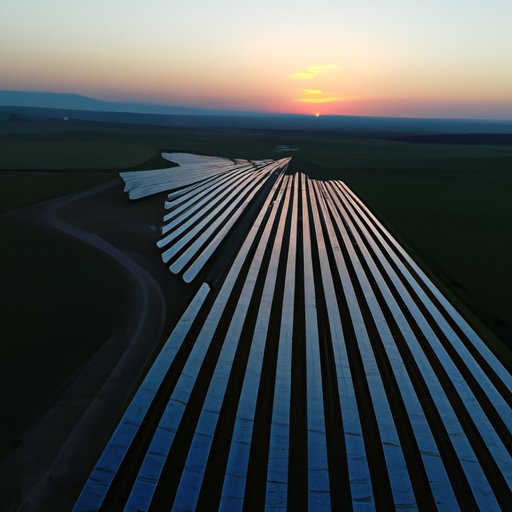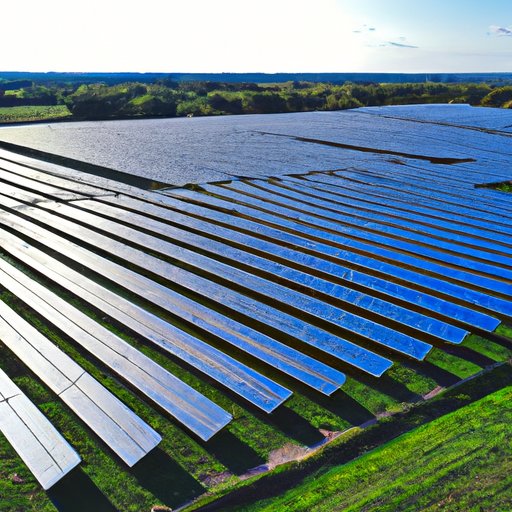Introduction
A solar farm is a large-scale photovoltaic system that uses solar panels to generate electricity. Solar farms are becoming increasingly popular due to their ability to save money on energy costs and reduce carbon emissions. With the right knowledge and resources, anyone can start their own solar farm and enjoy the many financial and environmental benefits it has to offer.

Overview of the Benefits of Solar Farms
Solar farms offer numerous advantages over traditional sources of energy. According to a study by the National Renewable Energy Laboratory, they can provide cleaner, more affordable energy while reducing greenhouse gas emissions. Additionally, they create jobs and stimulate economic development in the local area. Furthermore, solar energy is an abundant and renewable resource, meaning it will never run out.
On top of these benefits, solar farms also offer a unique opportunity for landowners to monetize their unused land. By leasing their land to a solar farm developer, landowners can earn additional income with minimal effort. This makes solar farms an attractive option for those looking to make money from their property.

Reasons to Start a Solar Farm
There are many reasons why someone might want to start their own solar farm. The most obvious benefit is the potential to make a profit. Solar farms can generate significant revenue through the sale of electricity to utilities or other commercial customers. Additionally, many states offer tax incentives and grants for those who invest in renewable energy sources, which can further increase profitability.
Aside from the financial benefits, there are also environmental and social considerations. Solar farms can help reduce our reliance on fossil fuels and contribute to a cleaner, healthier planet. They can also provide much-needed electricity to rural or underserved areas, helping to improve quality of life in these regions.
Outline the Steps Involved in Starting a Solar Farm
Before you start your own solar farm, it’s important to understand the steps involved. Here is an outline of the process:
1. Identify Potential Solar Farm Locations
The first step is to identify potential sites for your solar farm. Look for open, flat land with access to power lines and no shading from nearby trees or buildings. You should also consider the amount of sunlight the site receives, as this will affect the efficiency of your solar panels.

2. Research Local and State Regulations
Once you have identified a potential site, you need to research local and state regulations. Every jurisdiction has different rules and regulations regarding the construction and operation of solar farms, so it’s important to familiarize yourself with these before proceeding.
3. Consider Different Solar Technologies
When it comes to choosing solar technology, there are many options available. Photovoltaic (PV) systems, which use solar panels to convert sunlight into electricity, are the most common type of solar technology. Other technologies such as concentrated solar power (CSP) and solar thermal can also be used depending on your needs and budget.
4. Develop a Business Plan
Creating a business plan is essential for any successful venture. Your plan should include an overview of your goals, a timeline for completion, and a detailed budget. Additionally, it should outline any financing or partnerships you plan to pursue.
According to a report by the U.S. Department of Energy, “Developing a detailed business plan is key to the success of any solar energy project.”
5. Hire Experienced Professionals to Help with Setup and Maintenance
It’s important to hire experienced professionals to help with the setup and maintenance of your solar farm. This includes engineers, electricians, and technicians who can ensure that your solar farm is installed correctly and safely. Additionally, it’s wise to hire a lawyer to help with any legal issues that may arise.
Explore Available Financing Options
Once you have a business plan in place, it’s time to explore financing options. There are several ways to finance a solar farm, including:
1. Investigate Tax Incentives and Grants
Many states offer tax incentives and grants for those who invest in renewable energy sources. It’s important to research these options to see if you qualify for any of them. Additionally, the federal government offers tax credits for businesses installing solar energy systems, which can help offset some of the cost of the project.

2. Look Into Bank Loans and Other Credit Facilities
Bank loans are another way to finance your solar farm. Many banks offer loans specifically for renewable energy projects, so it’s worth exploring this option. Additionally, there are other credit facilities available, such as private equity and venture capital.

3. Consider Crowdfunding and Private Investment
For those who don’t qualify for traditional financing options, crowdfunding and private investment can be viable alternatives. Crowdfunding platforms such as Kickstarter and Indiegogo allow people to raise money from a wide range of investors, while private investors can provide larger sums of money in exchange for an equity stake in the company.
Conclusion
Starting a solar farm can be a rewarding experience, both financially and environmentally. It requires careful planning and research, but with the right resources and expertise, anyone can embark on this journey. By following the steps outlined above, you can get your solar farm up and running in no time.
Investing in solar energy is a smart decision that can provide long-term benefits for both individuals and society. Not only does it reduce our dependence on fossil fuels, but it also creates jobs and stimulates economic growth.
(Note: Is this article not meeting your expectations? Do you have knowledge or insights to share? Unlock new opportunities and expand your reach by joining our authors team. Click Registration to join us and share your expertise with our readers.)
